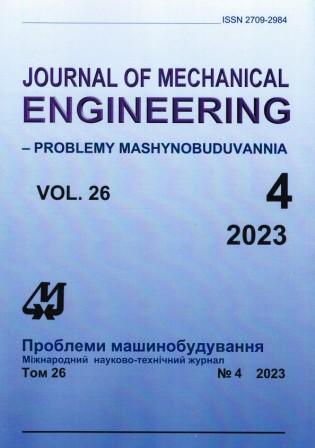Аналіз стійкості та коливань пористих степеневих та сигмовидних функціонально-градієнтних сендвіч-пластин методом R-функцій
Аннотация
У даній роботі вперше застосовано метод R-функцій для дослідження стійкості та коливань пористих функціонально-градієнтних сендвіч-пластин зі складною геометричною формою. Припускається, що зовнішні шари пластини виготовлено із функціонально-градієнтних матеріалів, а заповнювач є ізотропним, а саме керамічним. Диференціальні рівняння руху одержано за допомогою звичайної зсувної деформаційної теорії першого порядку із заданим коефіцієнтом зсуву (FSDT). Досліджено дві моделі розподілення пористості згідно із степеневим (P-law) і сигмовидним (S-law) законами. Одержані аналітичні вирази для обчислення ефективних механічних характеристик функціонально-градієнтних матеріалів при рівномірному й нерівномірному розподіленні пористості. Запропонований підхід враховує той факт, що докритичний стан пластини може бути неоднорідним, і тому перш за все визначаються напруження в серединній площині пластини, а потім розв’язується задача на власні значення з метою знаходження критичного навантаження. Для визначення критичного навантаження і частот пластин використано метод Рітца разом із теорією R-функцій. Розроблені алгоритми і програмне забезпечення перевірені на тестових прикладах і порівняні з відомими результатами, одержаними за допомогою інших методів. Розв’язано ряд задач стійкості й коливань пористих функціонально-градієнтних сендвіч-пластин зі складною геометричною формою для різних схем укладання шарів, різних крайових умов і законів розподілення пористості.
Загрузки
Опубликован
Выпуск
Раздел
Лицензия
Copyright (c) 2024 Л. В. Курпа, Т. В. Шматко, Г. Б. Лінник

Это произведение доступно по лицензии Creative Commons «Attribution-NoDerivatives» («Атрибуция — Без производных произведений») 4.0 Всемирная.
Авторы, публикующиеся в этом журнале, соглашаются со следующими условиями:
- Авторы оставляют за собой право на авторство своей работы и передают журналу право первой публикации этой работы на условиях лицензионного договора (соглашения).
- Авторы имеют право заключать самостоятельно дополнительные договора (соглашения) о неэксклюзивном распространении работы в том виде, в котором она была опубликована этим журналом (например, размещать работу в электронном хранилище учреждения или публиковать в составе монографии), при условии сохранения ссылки на первую публикацию работы в этом журнале.
- Политика журнала позволяет размещение авторами в сети Интернет (например, в хранилищах учреждения или на персональных веб-сайтах) рукописи работы, как до подачи этой рукописи в редакцию, так и во время ее редакционной обработки, поскольку это способствует возникновению продуктивной научной дискуссии и позитивно отражается на оперативности и динамике цитирования опубликованной работы (см. The Effect of Open Access).

